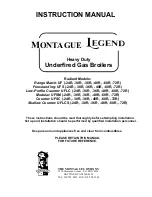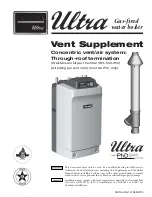
27
EN
T AT
maximum heating setpoint temperature (standard systems)
T BT
maximum heating setpoint temperature (free-standing systems)
3,0
100
90
80
70
60
50
40
30
20
20
Delivery temperature (°C)
External temperature (°C)
15
10
5
0
-5
-10
-15
-20
2,5
2,0
1,5
T AT
1,0
0,8
0,6
0,4
0,2
T BT
THERMOREGULATION CURVES
Offset on the reference ambient temperature
In any case, the user can indirectly modify the HEATING setpoint value
by defining, for the reference temperature (20°C), an offset that can vary
within the range -5 to +5 (offset 0 = 20°C). For the correction of the off-
set, refer to paragraph “7.3 Setting the heating setpoint with an external
probe
”.
90
80
70
60
50
40
30
20
10
30
Delivery temperature (°C)
External temperature (°C)
25 20 15
+5°C
20°C
-5°C
10
5
0
-5 -10 -15 -20
CLIMATIC CURVE CORRECTION
NIGHT-TIME COMPENSATION (parameter 420)
If a timer is connected to the AMBIENT THERMOSTAT input, parameter
420 can be used to enable night-time compensation.
Set parameter 420 = 1
In this case, when the CONTACT is CLOSED, the heat request is made
by the flow sensor, on the basis of the outdoor temperature, to obtain a
nominal ambient temperature on DAY level (20 °C). The
OPENING OF
THE CONTACT does not produce a switch-off, but a reduction (parallel
translation) of the climatic curve on NIGHT level (16 °C).
90
80
70
60
50
40
30
20
10
Delivery temperature (°C)
External temperature (°C)
20
15
10
5
0
-5
-10
-15
-20
PARALLEL NIGHT TIME REDUCTION
DAY TEMPERATURE CURVE
NIGHT TEMPERATURE CURVE
In this case too, the user can indirectly modify the HEATING setpoint
value by defining an offset on the reference DAY temperature (20°C)
or the reference NIGHT temperature (16°C) that can vary within
the range [-5 to +5].
NIGHT COMPENSATION is not available if OT+
chrono is connected. For the correction of the offset, refer to paragraph
“7.2 Setting the heating setpoint
”.
4.5
“DHW comfort” function
1
2
3
PHO
PH
1
PH2
PH3
+
>2 sec
PH
3
PH
1
PH
O
High efficiency mode
The boiler is equipped with an automatic function that is activated at
the first power supply or after 60 days of non-use (electrically powered
boiler). In this mode the boiler, for 60 minutes, limits the heating power to
a minimum and the maximum DHW temperature to 55°C.
Activating the chimney sweep temporarily disables this function.
During execution, the water pressure icon flashes and the display shows
:
A
°C
02
5
.
4.3 Venting cycle
Position the system’s master switch to the “on” position.
Every time the
boiler is powered, a 4-minute venting cycle is run. The display shows
.
To interrupt the venting cycle, press the key shown in the figure below.
bar
rpm
°C
1
88
8
.
1
ooo
b
When the venting cycle is running, all heat requests are inhibited
apart from DHW unless the boiler is OFF.
The venting cycle can also be interrupted (if the boiler is not OFF) by a
DHW request.
4.4 Setting the thermoregulation
The thermoregulation is only available if an external probe is connected,
and is only active for the HEATING function.
THERMOREGULATION is enabled in the following way:
set parameter 418 =1.
With 418 = 0 or the external probe disconnected, the boiler works with
a fixed point
.
The temperature value measured by the external probe
is visualised in “5.3 INFO menu
” under item I009. The thermore-
gulation algorithm will not use the measured external temperature value
directly, but rather a calculated external temperature that takes into ac-
count the building’s insulation: in buildings that are well insulated, the
outdoor temperature variations will have less impact than those that are
poorly insulated by comparison.
This value can be viewed in the INFO menu under item I010.
REQUEST FROM OT CHRONOTHERMOSTAT
In this case, the delivery setpoint is calculated by chronohermostat on
the basis of the external temperature value and the difference between
the real ambient temperature and the required ambient temperature.
REQUEST FROM ROOM THERMOSTAT
In this case, the delivery setpoint is calculated by the adjustment board
on the basis of the external temperature value, to obtain an estimated
ambient temperature value of 20° (reference ambient temperature).
There are 2 parameters that compete to calculate the output setpoint:
slope of the compensation curve (KT) - editable by technical staff
offset on the reference ambient temperature - editable by the user.
TYPE OF BUILDING (parameter 432)
It is indicative of the frequency with which the value of the calculated
outdoor temperature for thermoregulation is updated, a low value for this
value will be used for buildings that have little insulation.
SEXT REACTIVITY (parameter 433)
It is an indication of the speed with which variations of the measured
outdoor temperature affect the calculated outdoor temperature value for
thermoregulation, low values indicate high speeds.
Choice of the thermoregulation curve (
parameter
419
)
The thermoregulation curve for heating maintains a theoretical tempera-
ture of 20°C indoors, when the outdoor temperature is b20°C
and -20°C. The choice of the curve depends on the minimum outdo-
or temperature envisaged (and therefore on the geographical location)
and on the delivery temperature envisaged (and therefore on the type
of system). It is carefully calculated by the installer on the basis of the
following formula:
KT =
T. delivery envisaged - Tshift
20- T. min. design external
Tshift = 30°C standard system
25°C floor system
If the calculation produces an intermediate value between two curves,
you are advised to choose the thermoregulation curve closest to the va-
lue obtained.
Example
:
if the value obtained from the calculation is 1.3, this is betwe-
en curve 1 and curve 1.5. Choose the nearest curve, i.e. 1.5. The set-
table KT values are as follows:
standard system: 1,0÷3,0
floor system: 0,2÷0,8.
Parameter
419 can be used to set the required thermoregulation curve:
















































